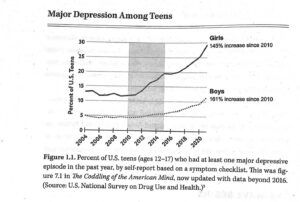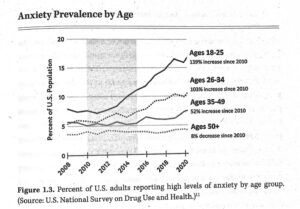The Problem With Kids Today
MAY 2025
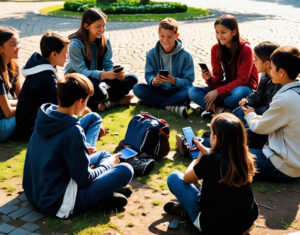
Every generation tends to find fault with the generation that follows. This trend dates all the way back to the Ancient Greeks, who criticized their youth for reading too many books. Older generations in modern times have often been critical of younger generations’ work ethic, dependence on technology, political views, cultural values, and more. Some of this criticism is based in reality, but not always. These days, parents are often critical of their children’s use of certain elements of technology.
If you are noticing your children spending more time alone, glued to a screen, or struggling with confidence in social settings, you’re not alone AND you’re not imagining things. Our children are growing up in a radically different world than we did. The question isn’t “what’s wrong with kids today?” … it’s “what has changed in the world around them?”
One thing that’s clear is that there has been a major transformation in the youth of today from just 15-20 years ago. Throughout this time, I have been a sales executive with an organization that has been highly significant throughout North America in terms of recruiting, training, and developing college students. I have directly interacted with many thousands of young people in my career, mentoring them on the skills to bridge the gap between formal education and what it takes to succeed in the real world.
A question I’ve been asked with increasing frequency is,
“How are the kids of today different from those of 10, 15, 20 years ago?
There are some clear differences I’ll attempt to articulate and explain here.
The advent of smart phones and social media have had a noticeable effect on the mindsets and behaviors of students today. First, social skills have noticeably declined, especially among boys. Of course there are always the super sharp kids who have become polished communicators. But on average, most of the young adults today are way behind in terms of their social communication skills. Another noticeable difference is in the area I would call resilience. The work that my company trains students to do is direct sales, and while our program has been streamlined to minimize friction points, there are still tasks that are hard and involve some degree of rejection and/or temporary failure. We see way more kids these days who give up very easily, and even those who can’t bring themselves to take the first steps after training.
Jonathan Haidt is a social psychologist and professor at NYU, where he, like me, has been able to directly interact with, observe, and get to know many students. He noticed a major shift that occurred between 2010 and 2015, and he has spent the past decade+ researching this trend. His findings closely match the two observations I shared in the previous paragraph. Much of what I’ll share in this article stems from ideas I have read or heard from Professor Haidt, so I’ll just credit him with extra emphasis right now rather than repeatedly throughout the article. The start of this transformation coincides with the advent of smart phones with the availability of social media apps.
Great Innovations, Unintended Consequences
Social media became prevalent in the mid 2000s. The premise was that social media would connect people. In reality, the connections are shallow and the time spent on social media hinders real connections with people who are closer to home. In the 2000s, though, social media was accessed via computer, and parents could much more easily regulate kids’ screen time at home.
The iPhone was first released in 2007. But those early versions were not like the miniature computers that we all have in our pockets or purses today. The App Store was introduced in 2009, and soon millions and millions of apps were available on this hand-held device that could be carried anywhere.
Push notifications eventually became pervasive attention grabbers, sowing a culture for all of us that interruptions are OK. The feeling of continuous partial attention has made us all feel snubbed in many of our interactions.
Kids were largely insulated from these effects at first. Childhood as most of us know it had a recognizably human form up until about 2010. But, as the decade of the 2010s unfolded, smart phones found their way into the hands of a progressively younger audience. Kids gradually started spending more time on their devices, at the expense of time hanging out in person with other kids. Fewer social interactions meant fewer opportunities for the development of social skills, and fewer strong bonds being established.
The lockdowns of the Covid-19 pandemic should have been a wake-up call for all of us to realize the importance of human-to-human interaction. But now, coming out of that phase, more and more young children are glued to their smartphones and spending many hours per day on social media. At least 4 or 5 of my daughter’s classmates had smartphones in 4th grade!
Have WE created The Anxious Generation?
In his book “The Anxious Generation,” Haidt creates a distinction between what he calls the “phone-based childhood” and the “play-based childhood.” When most of us were kids, we spent a significant amount of time in “free play” with other kids, often outdoors, usually unsupervised, creating a great opportunity to learn both physical and social skills. Free play gives kids confidence that they can face new situations, which is an inoculation against anxiety.
By contrast, the “phone-based childhood” experience inhibits important skill development and opens the doors for all sorts of other unintended consequences to form. Haidt identifies “4 Foundational Harms” that are occurring:
– Social Deprivation
– Sleep Deprivation
– Attention Fragmentation
– Addiction
Smart phones and social media have added 2-3 hours of ADDITIONAL screen-based activity on average to a child’s day. High-school aged kids today are spending 5-9 hours per day on their screens for leisure, with much of that time being on social media. Even if the effects of social media were neutral, how could that much time being spent away from real play and actual human interaction not have a powerful effect on children’s social development? Might they have exchanged any parts of life that were necessary for healthy human development?
Compounding the time factor is the profoundly negative effect that social media has been proven to have on young developing minds. There are many pathways by which social media is harming our kids.
• Social media, by its very nature, provides people with others’ highlight reels, not their actual day-to-day experience. This creates a false sense of reality. Children have the greatest vulnerability to manipulation of social media algorithms … their frontal cortices are still highly undeveloped.
• Impressionable young children are often drawn to bad role models. In following influencers who became famous for what they do in the virtual world, young people are often learning ways of talking, behaving, and emoting that may backfire in an office, family, or other real-world setting.
• Bullying is also rampant online. The culture of social media has led many people to feel very comfortable being aggressive, crude, or vulgar in online interactions. Children have not evolved to handle the anonymity, instability, and the potential for large-scale public shaming of the virtual world. Even adults have trouble with it.
• All of this has led to a spike in anxiety among the generation of kids growing up in this new era. The following charts from “The Anxious Generation” book show how anxiety and depression among teens have exploded in the past 10-15 years.
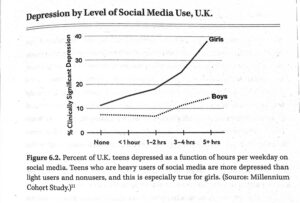
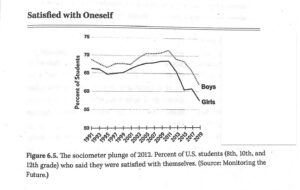
As soon as Gen Z arrived on campus, college counseling centers were overwhelmed. It’s becoming increasingly clear that the environment we’ve allowed to evolve may be working against our children’s well-being. BUT, we still have the power to course-correct.
For those of us with daughters, all of this has disproportionately affected girls. First of all, girls use social media more than boys. Beyond that, Haidt cites 4 reasons why girls are particularly vulnerable:
• Girls are more affected by visual social comparison and perfectionism.
• Girls aggression is more relational (while boys actually fight more).
• Girls more easily share emotions and disorders.
• Girls are more subject to predation and harassment.
This last point was particularly echoed during a presentation I attended by an officer with the San Jose Police Department. She walked through multiple ways that girls are targeted on social media apps, even on game apps as seemingly innocuous as Roblox. The most shocking statistic she shared was that when girls under 13 are on social media, the chances of them being targeted for some form of predation is upwards of NINETY PERCENT! Do you remember how we used to worry about actual kidnappers when we were kids? Well, all of those same bad people still exist, except now they mostly operate online.
What seems clear to me is that we, as a society, are now overprotecting our kids in the real world, and underprotecting them in the online world, and we need to reverse both of these trends.
Let’s start these new norms …
As a prescription for all of these challenges, Jonathan Haidt proposes “4 social norms” that he would like to see established far and wide. These are:
1) No smartphone before high school
2) No social media before 16+
3) Phone-free schools
4) Far more independence and free play in the real world.
I would add one idea, which is to KEEP SCREENS OUT OF KIDS’ BEDROOMS (by a certain time if they do homework in their room). I’m turning my dining room into a “study” with one desk for each kid against the opposite walls so that their computers will be facing out when they are being used. This will be their location for “working” and their bedrooms will be for sleeping, playing, reading, etc.
These are ideas that we should all be advocating for among our kids’ schools and within our communities. When many families impose similar guidelines, they break out of the collection action trap and everyone is better off.
Things Parents Can Do Now
• Please consider a Bark Phone or Gabb Phone for your middle-schoolers. These offer calling and texting with significant parental controls and an option for no internet.
• Hold off on Social Media access. Social Media is a tool, not a toy. If our children start using this tool in their Senior year of high school, they’ll have plenty of time to establish the following that they can build on and leverage in the future.
• Let’s all support phone-free schools. Not just having kids put their phones away during class and allowing them to use the phones during breaks and lunch, but instead a place where the entire school day is for learning and interacting in real life with others.
• Last, let’s all encourage our kids to have more “real-world” experiences. Increase their mobility, give them more responsibility at home, and let them have some adventures of their own. “Safety-ism” is actually dangerous because it makes it harder for children to learn to care for themselves and to deal with risk, conflict, and frustration. Less safety-ism is more likely to produce confident, competent young adults, with lower levels of anxiety.
There are many things in life that have grown big because people thought they were OK or even “cool” at first. Coca-Cola and cigarettes would be on this list, but we have all certainly learned now that these are vices to be avoided. It’s quite possible that some elements of the technology we hold so dear (especially where I live in Silicon Valley) could fall into the same category as we look back in the years ahead.
“Standing on a whale, fishing for minnows.”
This expression might perfectly sum up where we are today, and the real nature of the problems that our kids face. We all want to raise kids who are intelligent and capable, who will thrive in the complex world that’s coming. Maybe, in our rush to adapt to this new world, we have changed too much about the nature of childhood. The time is NOW to give our kids back a normal healthy human childhood. The prescriptions in this article will not LIMIT our children’s futures, but instead will MULTIPLY our children’s opportunities and happiness.
RESOURCES:
Visit AnxiousGeneration.com and order the book.
For kid friendly explanations of the science discussed in this article, get “Kids’ Brains & Screens” for kids and parents. Order it here.
More resources to follow, so check back here.
